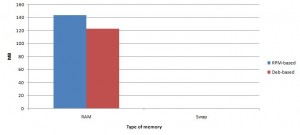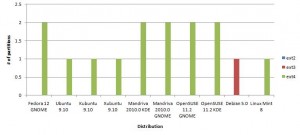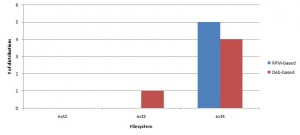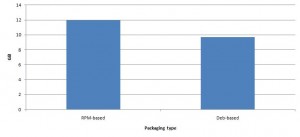As you know I am currently running OpenSUSE 11.2 on my laptop. While I have enjoyed my time using it, I have noticed that this particular distribution tends to be on the heavy side of memory usage. This got me thinking. If OpenSUSE uses this much memory on my machine, how could it possibly run on a machine with 512MB of RAM (the lowest recommended amount)? If Ubuntu is the most popular distribution, but it is also, what I would call, a fully-fledged desktop distribution, then how does it manage given tighter memory constraints? And so the mini-experiment begins.
Points to make before I begin
- This is not a very scientific study, but rather something I did in my spare time because I was curious.
- I have picked the majority of the most popular desktop distributions. These distributions were chosen not because they were designed for minimal system specs but rather because they are popular and provide a full desktop experience out of the gate.
- What do I mean by full desktop experience? The distribution should be easy enough for a novice Windows user to install, should come with all of the standard software for desktop activities, and should not require any fine tuning.
- What you won’t find here: DSL, Arch Linux, Slackware (only because it failed at installing in VirtualBox), Gentoo, or other ‘expert’ distributions. You also will not find netbook remixes or low-resource specific distributions. This experiment is designed to see how these big distributions run on little RAM, nothing more.
- Please do not post things like ‘you forgot to test XYZ’ or other useless comments that don’t actually help the discussion. Yes I am sorry I missed your favourite distribution, but grab a tissue, clear the tears from your eyes and let’s all move on with our lives.
How I tested them
The process was identical for all tested distributions. I set up a new virtual machine inside of VirtualBox with the following specs:
- Total RAM: 512MB
- Hard drive: 8GB
- CPU type: x86
The tests were all done using VirtualBox 3.1.4 on Windows, and I did not install VirtualBox tools (although some distributions may have shipped with them) nor did I change the screen resolution from the default 800×600.
Results
I have broken the results down into a variety of categories and included fancy graphs just for you!
First boot memory (RAM) usage
For this test I installed the distribution and then on its first (post-installation) boot measured the amount of memory it used. This was to gauge the amount of resources that the stock distribution required before any updates.
Average first boot memory (RAM) usage by packaging type
This shows the average memory usage broken down by the packing type used.
Memory (RAM) usage after updates
This was a test to see whether or not system updates caused the memory usage to increase or decrease. I updated the system with all current updates and then rebooted and measured the resource usage again.
Memory (RAM) usage change after updates
This graph shows the usage difference between installation and post-updating. The formula I used was [after updates – initial installation].
Average memory (RAM) usage after updates by packaging type
Similar to above. Again this is broken down by packing type.
Filesystem layout
This is a simple graph showing the partitions that each default setup created as well as the relative size of them.
Filesystems used in partitions
This graph shows the different filesystems used for the various partitions. For example if a distribution has a value of 2 under ext4 that means that it used ext4 in two different partitions.
Occurrence of filesystem by packaging type
This graph shows the number of distributions who used a certain type of filesystem. It is broken down by packing type.
Install size after updates
This is the total OS install size after downloading and installing all of the updates. This should represent a fully updated version of the distribution.
Average install size after updates by packaging type
This shows the average install size of the distributions broken down by packing type.
Conclusion
Make you own! …well it is pretty obvious that some of these distributions would perform better than others given these low system specs. There are however other things to consider. For example which packing type you prefer, or for that matter which package manager.











Nice effort and useful info. But why do you need a graph for file system type ?
The way I look at it: why not? Haha
Very good job. Thank you
Mandriva 2010.0 / Kde 4.3.2
Why Mandriva : http://linuxadvantage.blogspot.com/2010/02/mandriva-vs-ubuntu.html
boot in 15s with plymouth : http://www.youtube.com/watch?v=3Csb_t7-euY
A fresh openSUSE-install from a GNOME-LiveCD uses ~250 Megs of RAM. Try it.
I did. See the results above.
For Debian, was that Stable, or something newer like the Testing branch? Which desktop?
Looks like Kubuntu didn’t fair so well.
Debian stable with GNOME.
@lefty.crupps
I’ve been running Kubuntu on my desktop for just over three months now, and have found that it has all sorts of strange behaviour when it comes to memory. Sometimes it uses almost nothing, and other times, it’s like a leaky boat. I’ve also had some strange CPU behaviour, where the Xorg process starts to peg the CPU after about 24 hours of uptime. All in all, it’s a strange distro when it comes to system resource usage.
Thanks for this experiment. I’ve been looking for a new distro for my geriatric laptop. The biggest problem it has is limited memory, so this will at least tell me what to avoid.
The memory figure on Kubuntu after patching is quite scary. Is that with the PPA for the newest version of KDE enabled, or just with the updates to the base system? Do you have any thoughts on what might have caused that jump?
I’m surprised by the relatively low figure of Debian 5.0. Could that be because it’s using an older version of GNOME, or is there something else going on there?
A graph on GNOME vs. KDE based distros would have been interesting.
A piece on desktop memory and power usage, with a minimal look at growth over time, for those interested:
http://www.phoronix.com/scan.php?page=article&item=linux_desktop_vitals&num=1
It would be nice to get a feel for responsiveness of the desktops, too, but I don’t know off hand how to go about that. Does anyone have suggestions for desktop agnostic tools that try to capture that information?
Nope that was the stock Kubuntu 9.10 install and just base updates applied.
Potentially yes. I didn’t want to measure Debian testing because it can change so rapidly, but you are free to try yourself.
Taking a quick look at the above results its pretty clear that KDE tends to use more resources.
hubieran puesto a slackware y otras distros tambien conocidas, no me gusto que colocaran a kubuntu,xubuntu y todas sus derivaciones me parece algo inecesario, porque debian tambien utiliza xfce,kde,lxde, hubieran tomado todas las distros en su interfaz por defecto.
Saludos, 4 years with debian gnu/linux sid
please add slackware in your tests 😀
Now, please somebody explain me why my kde-fanboys friends always shout that KDE uses less RAM than GNOME????
[…] por esto que los chicos de The Linux Experiment han realizado un interesante pero improvisado estudio sobre cómo se comportan las distribuciones […]
[…] many people have shared their experiences with OpenSUSE, but here is one person who alludes to it. He looks for something lighter. As you know I am currently running OpenSUSE 11.2 on my laptop. […]
[…] many people have shared their experiences with OpenSUSE, but here is one person who alludes to it. He looks for something lighter. As you know I am currently running OpenSUSE 11.2 on my laptop. […]
[…] many people have shared their experiences with OpenSUSE, but here is one person who alludes to it. He looks for something lighter. As you know I am currently running OpenSUSE 11.2 on my laptop. […]
@alucardni
LOL it would be nice to redo the same comparison today with Gnome 3 !
And also notice the great increase of RAM consumption in Linux distributions
@Sylvainsjc
Yeah, it would be nice.